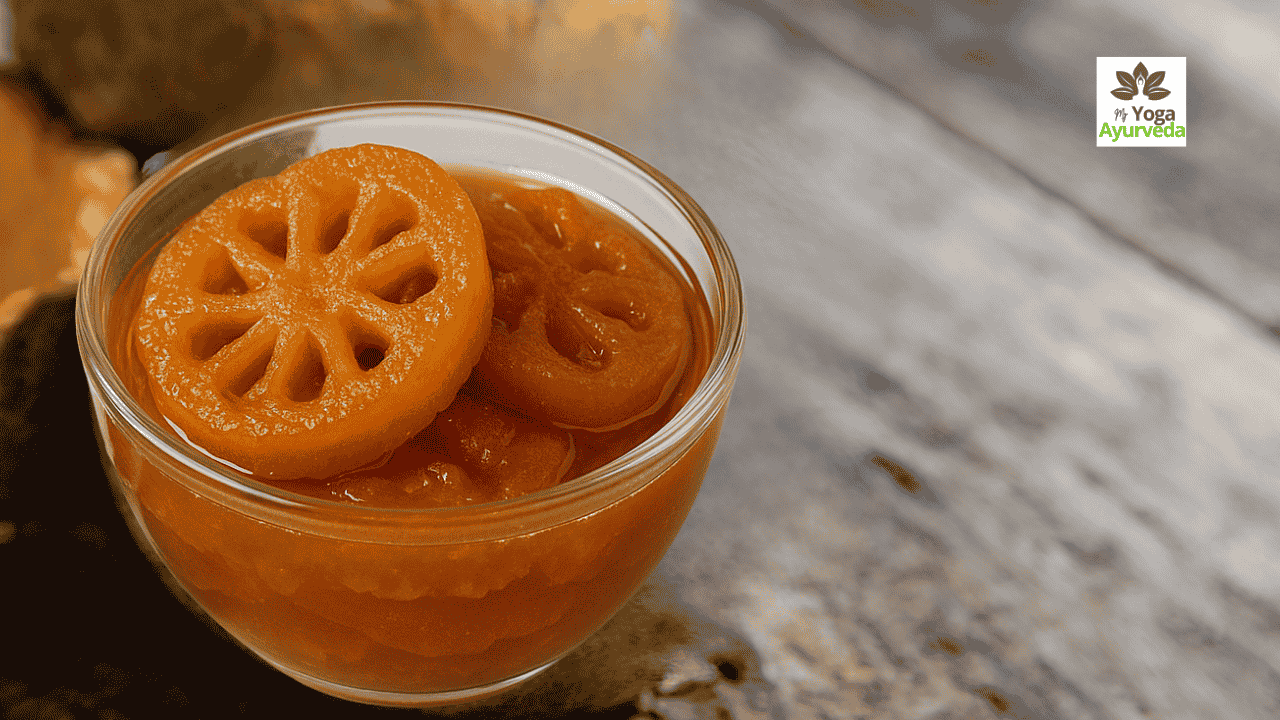
Written by Yoga Mentor Keshav, with facts sourced from Ancient Indian Ayurvedic and Yogic Textbooks, as well as scientific research.
In India, the Bel tree (Aegle marmelos), also known as the wood apple, is celebrated not just for its spiritual significance but also for its incredible health benefits and nutritional value. Revered in Hindu rituals, especially in the worship of Lord Shiva, the bel ke patte (leaves) are considered auspicious offerings.
The bel ke fal (fruit) is a powerhouse of wellness, used for centuries in Ayurveda for its medicinal properties. From its unique, hard shell to its fragrant, sweet pulp, Bel is increasingly recognized for its nutritional value and therapeutic benefits, making it a true treasure of nature.
The Bel tree grows in India and Southeast Asia and can live in many climates. Its fruit has a hard shell and soft, yellow pulp that smells nice and healthy.
Bel is known by many names across India and beyond, reflecting its well-known importance:
Sanskrit: Bilva, Shriphala
Hindi: Bel, Beli, Belgiri, Sirphal
Marathi: Bel
Bengali: Bael
Gujarati: Bilivaohal, Bili
Tamil: Vilvam, Vilva marum
Telugu: Maredu, Bilva pandu
Malayalam: Koovalam
Kannada: Bilvapatre
Oriya: Belo
In Ayurveda, Bel is highly valued for its healing properties. Known as Bilva, it is considered a remedy for various health issues, from digestive troubles to respiratory problems. According to Ayurveda, Bel can help balance the body’s doshas – Vata, Pitta, and Kapha – depending on its preparation.
The unripe fruit of Bel is especially useful for treating diarrhea and dysentery, as it has absorbent qualities. On the other hand, the ripe fruit is unctuous and slightly heavy, making it an effective laxative for relieving constipation.
Here is a popular Sanskrit shloka that praises the therapeutic qualities of Bel:
बिल्वं कषायमधुरं तिक्तरूक्षं महाफलम्। दीपनीयं वातजित् ग्राहि कटुपाकरसम् सरम्॥
This sloka describes Bel as having a sweet and astringent taste, with bitter and rough qualities. It is known for stimulating digestion, relieving Vata imbalances, and being mildly laxative.
Bel is not just medicinal; it is also a nutritious fruit that can support overall health. Here’s a breakdown of the approximate nutritional content in 100 grams of edible Bel pulp:
| Nutrient | Amount (Per 100 grams) |
|---|---|
| Energy | 88 kcal |
| Carbohydrates | 31.8–41.7 g |
| • Fructose | 1.01–1.55 g |
| • Glucose | 1.15–1.88 g |
| • Sucrose | 2.45–12.01 g |
| • Starch | 3.6 g |
| Protein | 1.6–8.81 g |
| Fat | 0.3–3.7 g |
| Fiber | 2.9 g |
| Vitamin C | 8–73.2 mg |
| Vitamin A (Carotene) | 55 mg |
| Thiamine (B1) | 0.13–0.16 mg |
| Riboflavin (B2) | 0.18–1.2 mg |
| Niacin (B3) | 0.87–1.1 mg |
| Calcium | 80–85 mg |
| Phosphorus | 50–52 mg |
| Potassium | 600–610 mg |
| Iron | 0.6–0.7 mg |
| Copper | 0.21 mg |
| Mineral Content | 1.7–1.9% |
Source: PMC
As you can see, Bel is rich in vitamin A, potassium, and vitamin C, which are essential for overall health.
Bel fruit is widely known for its positive effects on digestion. The unripe fruit is an effective remedy for conditions like diarrhea and dysentery, thanks to its absorbent properties.

It helps in managing atisara (diarrhea) by reducing water content and soothing the stomach. The ripe fruit, on the other hand, acts as a mild laxative, promoting smooth bowel movements and alleviating constipation. Consuming Bel ka sharbat or Bel juice is an excellent way to improve digestion and maintain a healthy gut. Evidence
Packed with essential vitamins and minerals, Bel is a nutritional powerhouse that helps boost immunity. It contains a good amount of Vitamin C, which is crucial for fighting infections and supporting the body’s natural defenses. The antioxidants in Bel, including flavonoids and phenolic compounds, help combat oxidative stress, reducing the risk of chronic diseases and strengthening overall immunity.
The anti-inflammatory properties of Bel are widely acknowledged in traditional medicine. Studies have shown that compounds in Bel fruit can help reduce inflammation, making it beneficial for managing conditions like arthritis and other inflammatory diseases. Consuming Bel murabba or Bel candy can provide relief from joint pain and other discomforts due to its natural anti-inflammatory effects. Evidence
Also Read : Ashwagandha for Pain Relief

Research indicates that Bel extracts may help manage blood sugar levels. The fruit contains compounds that have shown hypoglycemic (blood sugar-lowering) effects, making it beneficial for those with diabetes or those trying to prevent it. Regular consumption of Bel juice can be a natural way to maintain stable blood sugar levels. Evidence
Also Read: Benefits and Power of Triphala
Bel fruit is also considered heart-healthy due to its high content of potassium, calcium, and antioxidant,s which are essential for maintaining proper heart function and regulating blood pressure. Evidence
Also Read : 7 Simple Ways to Keep your Heart Healthy
Additionally, the fruit’s ability to support healthy circulation and strengthen the cardiac muscles makes it a beneficial addition to any heart-health-focused diet.
Bel has traditionally been used to support healthy lung function and manage respiratory issues like coughs and cold. The Kapha-balancing properties of the fruit and its leaves, known as Bel Patra, help clear mucus and promote better airflow.
Drinking Bel sharbat can provide soothing relief for respiratory conditions, acting as a natural expectorant.
Research has also shown that compounds in Bel can help protect the gastric mucosa and promote the healing of ulcers, aligning with its traditional use for stomach ailments. Evidence
The detoxifying properties of the Bel fruit help cleanse the body by flushing out toxins. The fruit’s natural ability to regulate digestion, improve gut health, and balance Vata and Kapha doshas makes it a great choice for a detox regimen. Drinking Bel juice or Bel ka sharbat is an easy and refreshing way to cleanse your system naturally.
In conclusion, the Bel fruit (Aegle marmelos) is a remarkable gift from nature, offering a mix of spiritual, nutritional, and medicinal benefits. Whether used in Ayurvedic remedies or enjoyed in traditional preparations like Bel sharbat and Bel murabba, this fruit supports digestive health, boosts immunity, and promotes overall well-being.
With modern science confirming its traditional uses, Bel is a valuable and versatile addition to a healthy lifestyle. By including Bel in our daily lives, we can benefit from its incredible properties to improve our health and vitality


